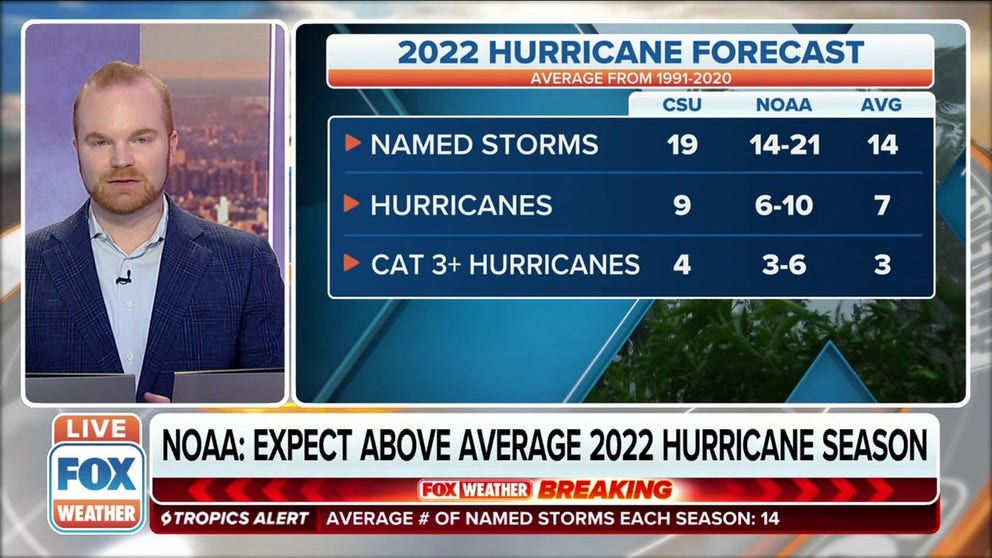For first time since 2014, Atlantic hurricane season might not start early
As of Wednesday, the National Hurricane Center was not monitoring any areas of the Atlantic Basin for potential tropical development during the next 5 days
NOAA says to expect an above-average 2022 Atlantic hurricane season
NOAA says they are expecting 14-21 named storms, 6-10 of them becoming hurricanes and 3-6 of those becoming major hurricanes.
It would be a first in eight years: The Atlantic hurricane season might not have a named storm before June 1.
The official Atlantic hurricane season runs from June 1 to Nov. 30, but a tropical cyclone developed earlier than that date in each of the last seven years from 2015 to 2021.
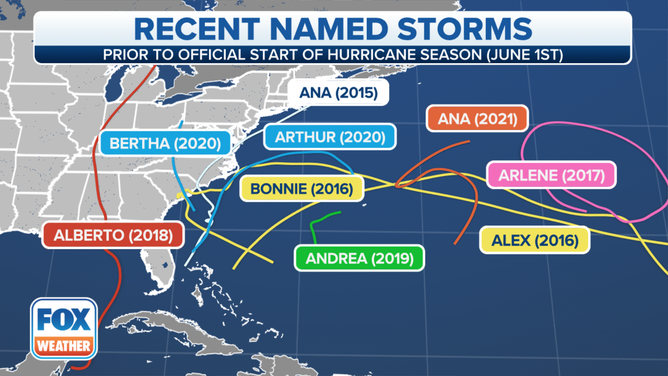
The tracks of pre-June 1 named storms in the Atlantic from 2015 through 2021.
(FOX Weather)
About 97% of all tropical storms and hurricanes in the Atlantic Basin, which includes the Atlantic Ocean, Caribbean Sea and Gulf of Mexico, occur during the six-month hurricane season. However, this recent seven-year stretch illustrated that tropical cyclones can roam the Atlantic before June 1 during what is technically the "offseason," proving that not every season follows the calendar.
HERE'S WHY THE ATLANTIC HURRICANE SEASON RUNS FROM JUNE TO NOVEMBER
According to the National Hurricane Center, only 3% of Atlantic tropical cyclones occur outside the official hurricane season. While the majority of out-of-season activity happens in May and December, there has been either an Atlantic tropical storm or hurricane in every month of the year, as can be seen in the graph below.
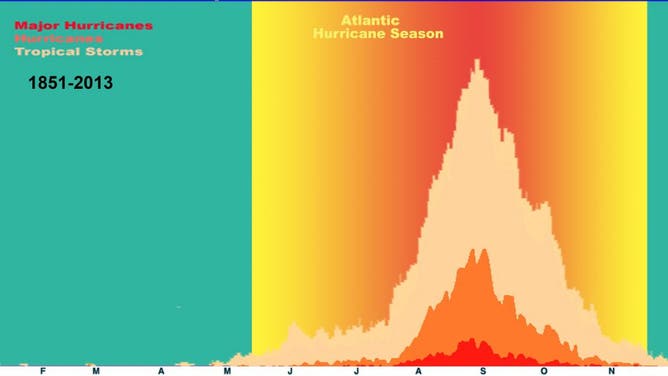
The Atlantic Basin shows a very peaked season from August through October, with 78% of the tropical storm days, 87% of the minor hurricane days and 96% of the major hurricane days occurring then. Maximum activity occurs in early to mid-September. "Out-of-season" tropical cyclones primarily occur in May or December.
(NOAA/AOML/HRD)
Could this streak of pre-June named storms finally come to an end?
With less than a week until the official start of the Atlantic hurricane season on June 1, time is running out for the streak of pre-June tropical cyclones to continue for an eighth consecutive year.
As of Wednesday, the NHC was not monitoring any areas of the Atlantic Basin for potential tropical development during the next five days.
HOW TO WATCH FOX WEATHER ON TV

(FOX Weather)
So, it appears the streak might finally be broken, but that doesn't mean fewer tropical storms and hurricanes will develop over the course of the Atlantic hurricane season.
The National Oceanic and Atmospheric Administration released its 2022 hurricane season outlook on Tuesday and expects another very active year in the Atlantic tropics.
Forecasters from NOAA's Climate Prediction Center are predicting 14 to 21 named storms, six to 10 hurricanes and three to six major hurricanes (Category 3 or higher on the Saffir-Simpson Hurricane Wind Scale). These numbers are greater than the 30-year averages (1991-2020) of 14 named storms, seven hurricanes and three major hurricanes.
If the outlook verifies, this will mark the seventh-consecutive above-average Atlantic hurricane season, NOAA administrator Rick Spinrad said.
NOAA FORECASTS ABOVE-AVERAGE 2022 ATLANTIC HURRICANE SEASON WITH UP TO 21 NAMED STORMS
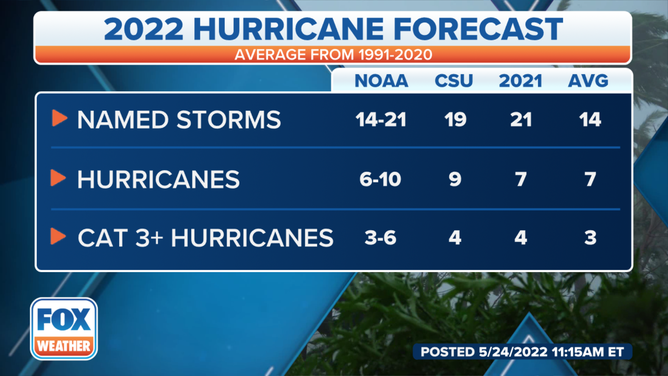
The NOAA and Colorado State University 2022 Atlantic hurricane season outlooks compared to 2021 and the 30-year averages (1991-2020).
(FOX Weather)
Pre-June named storms since 2015
Most recently in this seven-year stretch of early starts to the Atlantic hurricane season, Tropical Storm Ana briefly roamed the central Atlantic Ocean last year between May 22 and 23. It developed east of Bermuda but quickly moved northeastward away from the archipelago and out to sea.
Ana briefly produced gale-force winds over portions of Bermuda, but no other impacts were reported on land from this short-lived storm.
Two years ago, in May 2020, there was not one, but two tropical storms that had impacts in the U.S. Tropical Storm Arthur tracked just off the Southeast coast between May 16 and 19 and brought soaking rain to parts of eastern North Carolina.
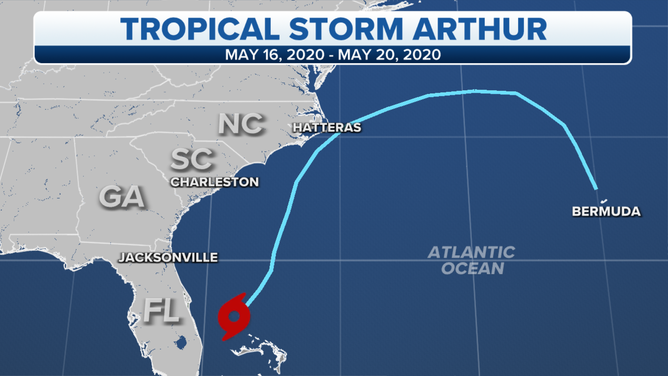
The track of Tropical Storm Arthur, May 16-20, 2020.
(FOX Weather)
The following week, Tropical Storm Bertha made landfall near the Isle of Palms, South Carolina, on May 27 with locally heavy rain and gusty winds. It dissipated over the Appalachians on May 28.
CLICK HERE TO GET THE FOX WEATHER UPDATE PODCAST
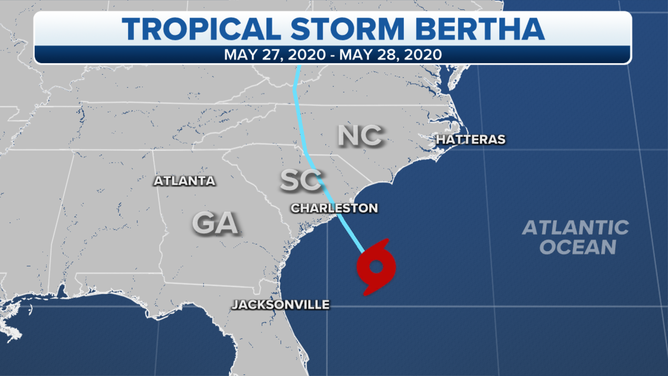
The track of Tropical Storm Bertha, May 27-28, 2020.
(FOX Weather)
May 2019 had Subtropical Storm Andrea the week before Memorial Day, but it stayed over the open waters of the Atlantic southwest of Bermuda.
Memorial Day 2018 was a memorable one for residents of the Florida Panhandle as Tropical Storm Alberto made landfall near the Bay/Walton County line for the unofficial start of summer. Alberto maintained its tropical characteristics all the way into Michigan.
The early start to hurricane season in 2017 was actually in April, when Tropical Storm Arlene developed over the open waters of the central Atlantic Ocean on April 20. It was only the second tropical cyclone on record in the Atlantic to form in April; Ana in 2003 was the first, according to the NHC.
WHERE TROPICAL STORMS, HURRICANES TYPICALLY OCCUR DURING EACH MONTH OF ATLANTIC HURRICANE SEASON
If you thought that was an early start to the season, think again. In 2016, Hurricane Alex formed in January in the northeastern Atlantic Ocean. It went on to make landfall as a tropical storm in the Azores on Jan. 15 with maximum sustained winds of 65 mph.
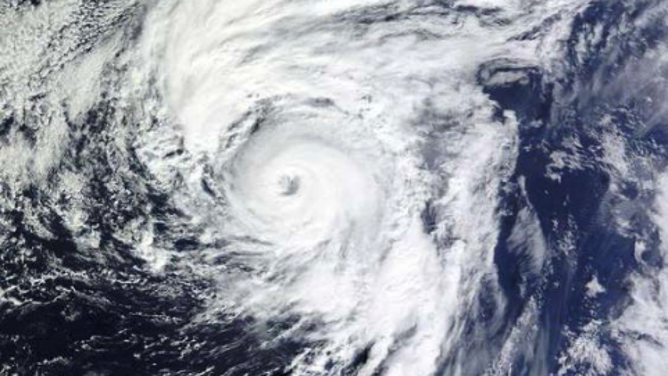
NASA-MODIS satellite image of Alex at 10:30 a.m. Eastern time on Jan. 14, 2016.
(NASA-MODIS)
Then, Tropical Storm Bonnie became the second pre-season storm of 2016 in May. It made landfall as a tropical depression on May 29 on the Isle of Palms, South Carolina, and dumped heavy rainfall along coastal sections of the Carolinas.
On Mother’s Day weekend in 2015, Tropical Storm Ana – the same name as the "A" storm in 2021 since Atlantic tropical cyclone name lists are reused every six years – made landfall along the northeastern coast of South Carolina near North Myrtle Beach. Its early-morning landfall on May 10 was the second-earliest U.S. landfall by any tropical cyclone on record, behind only a February 1952 tropical storm that made landfall in Florida, according to Eric Blake, a senior hurricane scientist at the NHC.
Despite this seven-year streak from 2015 through 2021, the NHC has not yet adjusted the start date of hurricane season, although in 2021, it did begin issuing routine Atlantic tropical weather outlooks on May 15 instead of the usual June 1.
WHY THE START DATE OF THE ATLANTIC HURRICANE SEASON WON'T CHANGE ANYTIME SOON
According to the NHC, the peak of hurricane season is from mid-August to late October, with Sept. 10 marking the official peak date of the season.
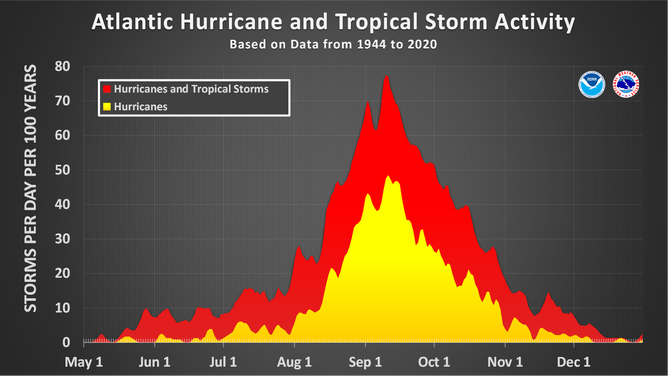
The official hurricane season for the Atlantic Basin (the Atlantic Ocean, Caribbean Sea and Gulf of Mexico) is from June 1 to Nov. 30. As seen in the graph above, the peak of the season is Sept. 10. However, deadly hurricanes can occur anytime in the hurricane season.
(NOAA/NHC)
